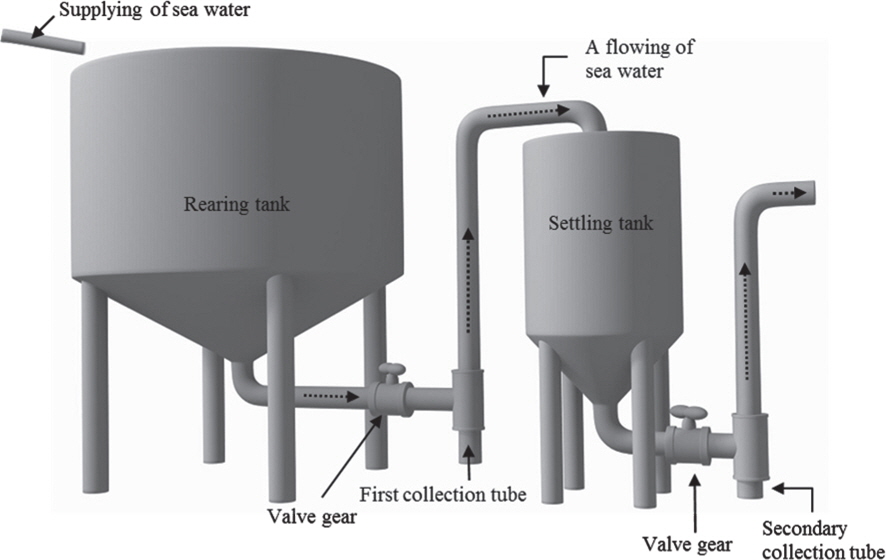



An 8-week feeding trial was conducted to determine the apparent dry matter and protein digestibility of seven different dietary protein sources by juvenile river puffer
배합사료 가격은 사료원료 비용의 50-70%를 차지하기 때문에 경제적이고 효율적인 사료를 생산하기 위해서는 사료원료의 가격에 대비한 품질평가가 필수적이다(Jafri and Hassan, 1999). 사료원료의 품질평가 방법 중에서 그 원료의 영양소 소화율을 측정하는 것이 가장 기본적인 방법 중의 하나이다. 일반적으로 사료원료들의 영양소 소화율 평가는 기초사료와 평가하고자 하는 사료원료를 7:3 비율로 혼합하여 제조한 사료를 실험어에게 공급하여 이루어지는데, 이것은 평가하고자 하는 사료원료가 다른 사료원료에 의해 받는 영향을 최소화 시키기 위함이다(Yoo et al., 2006). 또한, 원료의 소화율 측정은 경제적인 실용사료 설계, 영양연구의 기초자료 및 원료의 영양학적 가치를 결정하는데 매우 필수적인 자료가 된다.
일반적으로 어류는 탄수화물에 대한 이용성이 낮아 다른 육상동물에 비해 사료내 단백질이 차지하는 비율이 높고, 어류의 성장에 있어서 양어사료원료 비용 중 단백질원의 비용이 약 60% 이상을 차지하기 때문에 양어사료에서 양질의 단백질 원료의 선택은 매우 중요하다. 양어사료에서 어분은 영양소 함량이 높고, 어류의 기호성이 좋아 가장 많이 사용되고 있는 사료원료이다. 하지만, 최근에 어획량의 감소에 따른 수급불균형 및 가격상승 등으로 안정적인 단백질원의 공급이 위협 받고 있는 실정이다. 따라서 양어사료 영양학자들은 어분대체품으로 식물성 단백질원 및 동물성 부산물 단백질원을 이용하여 값비싼 어분 대신 값싸고 공급이 안정적인 사료원을 부분적 또는 완전히 대체하기 위한 노력을 계속하고 있다. 단백질 원료를 연구하는데 소화율 실험은 거의 필수적으로, 여러 가지 단백질 원료에 대한 영양소 및 에너지 소화율은 연어(Hajen et al., 1993), 넙치(Lee et al., 2008), 돌돔(Ko et al., 2008), 조피볼락(Lee, 2002) 및 이스라엘 잉어(Kim et al., 1997) 등 다양한 양식어류에서 보고된바 있으나, 황복을 대상으로 수행한 연구는 보고 되지 않았다.
그러므로 본 실험은 치어기 황복을 대상으로 동·식물성 단백질 사료원료들의 이용성을 평가하여 경제성 있는 황복의 배합사료 개발을 위한 기초자료를 제공하고자 실시하였다.
사육실험에 앞서 황복(
실험에서 사용한 기초사료(basal diet, BD)의 성분은 Table 1에 나타내었다. 기초사료는 단백질원으로 갈색어분과 황복 근 육분을, 탄수화물원으로는 밀가루를 사용하였고, 어유를 지질원으로 사용하였다. 황복 근육분은 중량 400 g 내외의 황복으로 부터 근육을 뼈와 분리 한 후 동결 건조하여 분말로 만들어 사용하였다. 단백질 원료들의 소화율 평가를 위한 실험사료는 기초 사료 70%와 7가지의 동·식물성 단백질원을 30% 비로 혼합하여 제조하였다. 본 실험에 사용된 7가지 단백질원은 백색어분(white fish meal, WFM), 갈색어분(brown fish meal, BFM), 오징어간분(squid liver powder, SLP), 크릴분말(krill meal, KM), 수지박(leather meal, LM), 대두박(soybean meal, SM) 및 발효대두박(fermented soybean meal, FSM)이며, 실험사료의 각 원료 및 기초사료를 포함한 8가지 실험사료의 성분조성은 Table 2 및 3에 나타내었다. 모든 사료는 실험사료원들의 소화율평가를 위하여 소화율 지시제로 이용되고 있는 Cr2O3를 0.5% 첨가하여 원료를 혼합 후 펠렛제조기로 압출·성형하였다. 실험사료의 입자크기는 sieve로 고르게 친 후, 밀봉하여 –20℃에 냉동 보관하면서 사용하였다.
[Table 1.] Composition of the basal diet
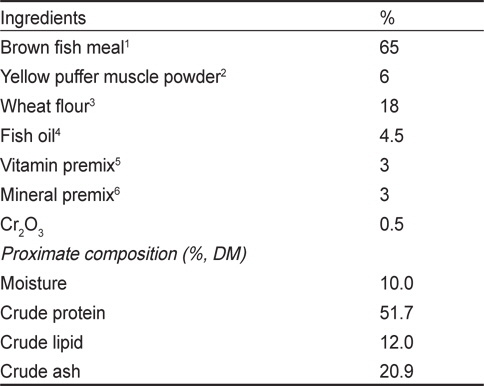
Composition of the basal diet
[Table 2.] Proximate composition of dietary protein sources (%, DM)

Proximate composition of dietary protein sources (%, DM)
[Table 3.] Chemical composition of reference and test diets (%, DM)
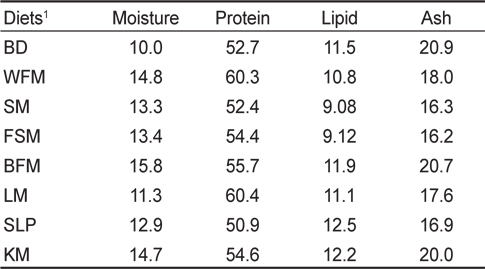
Chemical composition of reference and test diets (%, DM)
어체 측정은 2주 간격으로 실시하였으며, 성장률을 측정하기 위하여 24시간 절식시킨 후 MS-222 (100 ppm)로 마취시켜 전체무게를 측정하였다. 실험종료 후, 증체율(percent weight gain, %), 일간성장률(specific growth rate, %/day), 단백질전환효율(protein efficiency ratio), 사료효율(feed efficiency, %), 비만도(condition factor), 간중량지수(hepatosomatic index), 내장중량지수(visceralsomatic index) 및 생존율(survival rate, %)을 조사하였다. 간중량지수 및 내장중량지수 측정을 위해 각 수조별로 5마리씩 실험어를 포획하여 간 및 내장의 무게를 측정하였다.
실험사료와 각 수조별로 5마리씩 무작위로 추출한 실험어를 분쇄한 전어체의 일반성분은 AOAC (Association of Official Analytical Chemists, 2000)방법에 따라 수분은 상압가열건조법(135℃, 2시간), 조단백질은 kjeldahl 질소정량법(N×6.25), 조회분은 직접회화법으로 분석하였다. 조지방은 샘플을 12시간 동결 건조한 후, soxtec system 1046 (Tacator AB, Sweden)을 사용하여 soxhlet 추출법으로 분석하였다. 실험종료 후, 혈액성분 분석을 위하여 실험어를 각 수조당 3마리씩 무작위로 추출한 후 일회용 주사기를 이용하여 실험어의 미부정맥에서 혈액을 채혈하고 micro-hematocrit 방법으로 헤마토크리트(hematocrit, PCV)를 측정하였으며, 동시에 Drabkin's 용액을 사용하여 cyan-methemoglobin 방법(Sigma Chemical, St. Louis MO; total hemoglobin procedure No. 525)으로 헤모글로빈(hemoglobin, Hb)을 측정하였다.
성장 실험종료 후, 실험 어류를 자체 제작한 분수집 장치로 이동시켜 소화율 측정에 이용하였다(Fig. 1). 사료공급은 매일 10시와 16시에 하였으며, 최종 사료공급 후 1시간 뒤에 사료 찌꺼기를 제거하였다. 분은 다음날 8시에 분수집 장치에 모인 분을 수거하였다. 이와 같은 방법으로 10일 동안 분을 수집 하였으며, 회수된 분은 동결 건조시킨 후 분쇄하여 분석 전까지 -20℃에 보관하였다. 실험사료와 분의 소화율 지시제인 Cr3O3함량은 ICP (Inductively Coupled Plasma, Perkinelmer ICPOES 2000DV, USA)를 이용하여 분석하였으며, Sugiura et al.(1998)에 의한 공식으로 다음과 같이 소화율을 계산하였다.
Apparent digestibility coefficients of dry matter (ADCs of DM, %) = 100×[1- Cr2O3 in diet (%) / Cr2O3 in feces (%)]
ADCs of nutrients (%) = 100 - [{nutrient in feces (%) × Cr2O3 in diet (%)} ÷ {nutrient in diet (%) × Cr2O3 in feces (%)}×100]
ADCs of the test ingredient (%) = 100/30×(ADCs in test diet - 0.7×ADCs of basal diet)
모든 자료의 통계처리는 Computer Program Statistix 3.1(Analytical Software, St. Paul MN. USA)로 분산분석(ANOVA test)을 실시하여 최소유의차검정(LSD: Least Significant Difference)으로 평균간의 유의성(
소화율평가는 양식어류의 배합사료에 사용할 사료원료를 선정하기 위해 그 원료의 가치를 평가하는데 가장 중요한 방법이다(Kim et al., 2010). 사료원료의 소화율에 대한 정보는 영양소 이용가능 양을 대략적으로 공급하기 때문에 어류의 성장을 최대화 시킬 수 있는 사료의 제작 뿐만 아니라 사료허실에 따른 오염을 줄일 수 있어 매우 유용하게 활용된다(Zhou et al., 2004). 사료이용률은 단백질 원료에 따라 차이를 나타내며, 어분은 높은 단백질함량, 아미노산조성의 균형 및 높은 기호성으로 어류를 위한 최적의 단백질원으로 여러 어종에서 이미 잘 알려져 있다(Zhou et al., 2004; Jang et al., 2005; Kikuchi and Furuta, 2009). 황복 치어를 대상으로 한 본 연구에서도 단백질 사료원료의 소화율 평가결과 갈색어분(WFM) 및 백색어분(BFM) 실험구가 다른 동·식물성 단백질원료(수지박; LM, 오징어간분; SLP, 크릴분말; KM, 대두박; SM 및 발효대두박; FSM)에 비하여 건물소화율 및 단백질소화율이 유의한 차이로 높게 나타났다(Table 4). Kim et al. (2010)은 넙치를 대상으로 어분의 종류 및 품질에 따른 소화율을 평가하기 위하여 단백질 원료로 백색어분, 청어분, 연어분, 멸치어분을 이용하여 실험 한 결과 각 원료의 건물소화율 및 단백질소화율이 백색어분(79%, 95%), 연어분(77%, 94%), 멸치분(76%, 92%) 및 청어분(77%, 94%)로 유의한 차이가 나타나지 않는다고 보고하였다. 이러한 결과는 본 실험에서 단백질 함량이 77%인 백색어분(WFM)과 66%인 갈색어분(BFM)을 실험구로 하여 비교 분석한 결과, 두 실험구간 증체율(69.2%, 82.3%), 건물소화율(78.1%, 80.5%) 및 단백질소화율(95.7%, 96.0%)에 있어서 유의한 차이가 나타나지 않은 것과 유사하였다. 한편, 발효대두박 및 오징어간분의 건물소화율 및 단백질소화율은 백색어분 및 갈색어분과 유의한 차이가 나타나지 않았으나, 대두박, 수지박 및 크릴분말 실험구 보다 유의한 차이로 높게 나타났다. 육성기 넙치에 있어서 백색어분의 건물소화율과 단백질소화율이 각각 79%와 95%인 반면, 오징어간분의 건물소화율 및 단백질소화율이 각각 72% 및 89%로 낮게 나타났으며(Kim et al., 2010), 황복을 대상으로 수행한 본 연구에서도 오징어간분의 건물소화율 및 단백질소화율은 각각 66.6% 및 91.8%로 백색어분 보다 유의한 차이로 낮게 나타났다. Zhou et al. (2004)는 cobia를 대상으로 단백질원료로 어분과, 수지박을 이용하여 소화율을 평가한 결과 어분의 건물소화율 및 단백질소화율이 각각 87.7% 및 96.3%인 것에 비하여, 수지박의 건물소화율 및 단백질소화율이 각각 60.4% 및 87.2%로 수지박이 어분에 비하여 유의한 차이로 낮게 나타났다고 보고하였다. 이러한 결과는 본 실험에서 수지박의 건물소화율 및 단백질소화율이 각각 56.2% 및 88%로 어분 실험구에 비하여 유의한 차이로 낮게 나타난 것과 유사하였다. 또한, 넙치를 대상으로 수행한 실험(Yoo et al., 2006)에서도 백색어분의 단백질소화율 86%에 비하여 수지박의 단백질 소화율이 72%로 유의한 차이로 낮게 나타난 결과와도 유사하였다. Laining et al. (2003)은 humpback grouper를 대상으로 어분과 새우분말을 단백질원료로 이용하여 소화율을 평가한 결과 어분의 건물소화율 및 단백질소화율이 각각 59% 및 82%이며, 새우분말의 건물소화율 및 단백질소화율은 각각 58% 및 78%로 두 원료간에 유의한 차이가 나타나지 않는다고 보고하였다. 그러나 본 실험에서는 크릴분말의 건물소화율 및 단백질소화율이 각각 53.8% 및 89.1%로 실험에 사용된 동물성 단백질 원료 중 가장 낮았다. 이러한 결과는 본 실험에 사용하기 위하여 구입한 크릴분말이 미세하게 분쇄되지 않아 크릴의 갑각이 원료에 다량으로 포함되어 있었고, 분수집시에도 실험어가 소화 시키지 못해 분으로 배출된 것을 확인할 수 있었는데, 이러한 이유로 본 실험에서 크릴분말의 소화율이 낮게 나타난 것으로 판단된다. 식물성 단백질 원료인 대두박의 건물소화율(54.7%) 및 단백질소화율 (86.3%)은 다른 단백질원료에 비하여 가장 낮게 나타났으며, 자주복(Kikuchi and Furuta, 2009), 조피볼락(Lee, 2002), seabass (Tantikitti et al., 2005), hadddock (Tibbetts et al., 2004) 및 무지개송어(Cheng and Hardy, 2003)의 결과와 유사하였다. 식물성 단백질원료의 소화율이 낮게 나타나는 이유는 식물성원료에 탄수화물의 함량이 높은데 반하여 황복을 포함한 잡식성어류는 탄수화물 이용성이 낮기 때문이라고 알려져 있다(Chong et al., 2003; Bonaldo et al., 2006). 한편, 본 실험에서 대두박을 발효 가공 처리함으로써 건물소화율(71.7%) 및 단백질소화율(93.1%)이 확연하게 개선되는 효과를 나타냈다. 이러한 결과는 효모 등 미생물을 이용하여 전처리한 대두박을 공급한 결과 European sea bass (Tibaldi et al., 2006)와 조피볼락(Yoo et al., 2005)의 대두박 이용성을 향상시킨다고 보고된 것과 유사하였다.
[Table 4.] Apparent digestibility of dry matter and protein of seven different protein sources1
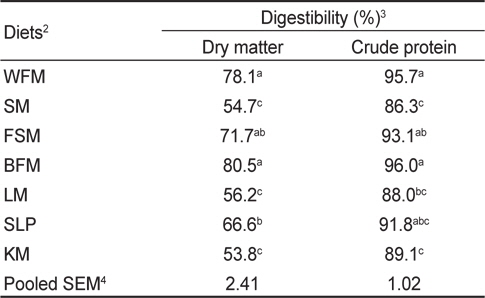
Apparent digestibility of dry matter and protein of seven different protein sources1
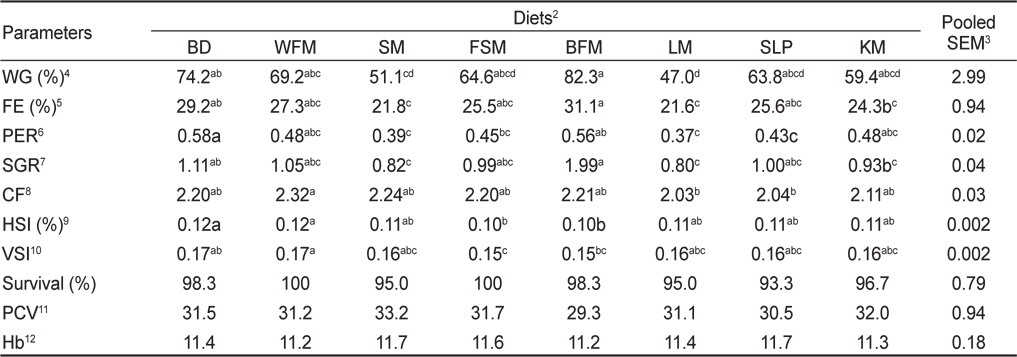
Growth performance of juvenile river puffer Takifugu obscurus fed eight experiment diets for 8 weeks1

Whole body composition (%, DM) of juvenile river puffer Takifugu obscurus fed eight experiment diets for 8 weeks1
8주간의 성장평가 결과는 단백질 원료의 건물소화율 및 단백질소화율의 결과와 유사한 경향을 나타내었다(Table 4). 증체율, 사료효율 및 일간성장률은 갈색어분 실험구가 대두박 및 수지박 실험구에 비하여 유의한 차이로 높게 나타났으며 (
따라서, 본 연구의 소화율 및 성장평가 결과를 통하여 볼 때, 황복 배합사료의 단백질원료로 백색어분, 갈색어분, 발효대두박 및 오징어간분이 활용 가능할 것으로 판단되며, 이러한 결과는 경제적이면서 영양학적으로 적합한 황복 배합사료를 설계하는데 기초 자료로 활용할 수 있을 것이다.



